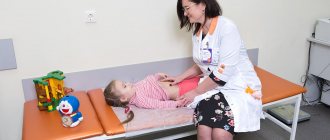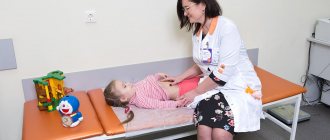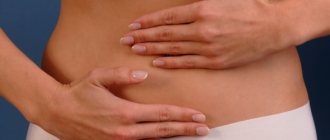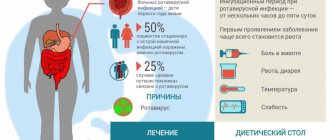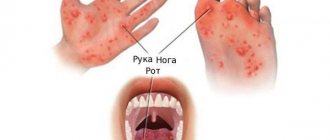Rotovirus infection is an acute form of pathology in which the gastrointestinal tract is damaged and a clear clinical picture develops. Symptoms include dyspeptic disorders, intoxication and dehydration. The condition is common, occurring in adults and children.
Causes of rotavirus infection
The main cause of the infectious disease is a viral pathogen of the rotavirus genus. The latter, when it enters the human body, contributes to the formation of all kinds of combinations, causing a wide variety of rotavirus strains. The most significant in the occurrence of the disease is considered to be the serotype of group A, which includes 4 different combinations.
Externally, the virus has the shape of a circle, 65-70 nm in size. It has a core, double RNA and a protein shell.
The pathogen is highly contagious and very resistant to adverse external factors. The virus remains viable at low temperatures, exposure to ultraviolet rays, antibacterial drugs, chemotherapy drugs and disinfectants. However, rotavirus does not tolerate heat, acid or alkali. In the environment, the pathogen can be active for 10-30 days, and in the stool of a sick person it retains the ability to infect for a maximum of 6 months.
Infection with the pathology occurs predominantly through the fecal-oral route, also by air, household and contact.
Contributing factors to the disease are dirty dishes, hands, contaminated water and food.
Among food products, dairy dishes, raw vegetables, fruits and drinks pose the greatest health hazard.
How to avoid getting infected with rotavirus, intestinal flu and other infections?
There are a few simple rules:
- Wash your hands thoroughly with soap after visiting public places, toilets, and transport.
- Consume only thermally processed foods: especially meat, fish and eggs. Be careful with dairy and lactic acid products
- Wash vegetables and fruits
- Avoid expired products
- Drink only bottled or boiled water (especially on vacation), do not swallow water when swimming in open water.
All intestinal infections have a high degree of contagiousness, or infectiousness - the ability to be transmitted from organism to organism. Risk groups include young children and the elderly, patients with immunodeficiency, and employees of medical institutions and catering establishments.
You can get a stomach infection again because you don't develop immunity to it. However, a strong and rich intestinal microbiota will help prevent infection and ease the course of the disease. The more diverse the composition of the microbiota, the stronger the immune system and the body's immune response. This is why it is so important to take care of beneficial bacteria and maintain their balance in the intestines.
You can find out how diverse your microbiota is with the Atlas Microbiota Test.
Symptoms of rotavirus
The occurrence of infection begins with the penetration of the pathogen into the human body. There it becomes embedded in the digestive tract and provokes the development of symptoms. The first signs are observed after the incubation period, which lasts 2-3 days, a maximum of a week.
In most cases, the disease occurs in an acute form with a clear clinical picture. Symptoms of an infectious condition are:
- Increase in body temperature. As a rule, it lasts no longer than 4-5 days and is accompanied by general weakness, malaise, headache and lack of appetite.
- Vomiting is characteristic of rotavirus and can occur in mild, moderate and severe forms. Lasts 1-2 days. When profuse vomiting occurs, it causes dehydration.
- Diarrhea - develops separately or together with vomiting. The stool is very copious, liquid, similar to water, with foam and various impurities, even streaks of blood. Sometimes mucus is present, and the stool has an unpleasant sour smell. The duration of diarrhea is 4-5 days, with a frequency of up to 5 times a day. Diarrhea is almost always accompanied by flatulence.
- Pain syndrome. Has a different nature of intensity and localization. More often the pain is acute, less often it is cramping.
- Dehydration of the body. Appears against a background of vomiting and diarrhea. In severe cases, fluid loss leads to the development of seizures and loss of important electrolytes with fluid. This condition is very dangerous and requires timely treatment.
- Catarrhal phenomena. Characterized by cough, impaired nasal breathing, throat hyperemia and soreness.
Diagnostics
Establishing the diagnosis of ACI is carried out in two stages:
- Stage I - a preliminary diagnosis is established on the basis of anamnesis, age factor, epidemiological situation in a particular region, clinic, taking into account the localization and nature of the pathological process in the gastrointestinal tract.
In a preliminary diagnosis in adults, in the presence of a typical symptom complex, the presumptive nosological form should be indicated; in the case of a mild or atypical course of the disease, the leading clinical syndrome and the severity of the disease should be indicated. - Stage II - final diagnosis. It is carried out on the basis of the dynamics of the development of the disease and the results of laboratory tests, which make it possible to clarify the localization of the process in the gastrointestinal tract and the etiology of the disease.
Laboratory diagnostics
Instrumental diagnostics
Sigmoidoscopy examination (for protracted and chronic forms of salmonellosis, dysentery, campylobacteriosis, etc.)
Diagnosis of acute intestinal infections caused by opportunistic microorganisms
- The patient has clinical signs of an acute infectious disease
- Isolation of opportunistic flora in the first days of illness in monoculture from feces, vomit or gastric lavage, from the remains of a food product with which the patient associates the disease
- The massiveness of the release of opportunistic flora in the early periods of the examination (106 or more microbial cells in 1 gram of feces)
- Reducing the quantitative content of opportunistic flora in the dynamics of the disease
Methods for treating rotovirus
To treat rotavirus pathology, symptomatic and etiological therapy is prescribed. Patients are also prescribed a diet and auxiliary methods.
The main goal of treatment is to prevent dehydration. For this purpose, rehydration drugs are used for parenteral and oral administration. Such drugs prevent large fluid loss, improve well-being and relieve intoxication syndrome. Representatives are: Regidron, Acesol, Kvartasol, Refortan.
To remove pathogenic pathogens from the body, sorbents are prescribed. They accelerate the restoration of the mucous membrane, suppress pain and flatulence. Activated carbon, Polysorb, Enterosgel, Karbolen are prescribed.
Antiviral drugs based on interferon are indicated as etiotropic treatment.
To improve the normal intestinal microflora, probiotics are prescribed - Acipol, Linnex, Enterol, Bifiform.
Additionally, patients with rotavirus pathology are prescribed painkillers, antiemetics and antipyretics.
Rotovirus infection in children
The course of the infectious process in childhood is almost no different from the clinical course in adults. The symptoms are similar, but there are some differences. In children, when the temperature rises, generalized convulsions are often observed, which lead to loss of consciousness and encephalitic signs are recorded.
In newborn children, rotavirus infection is often latent in nature without pronounced symptoms of gastrointestinal upset and high fever. However, with mass infection of babies, the disease can acquire a severe clinical form with profuse vomiting, diarrhea and dehydration.
As a rule, the incubation period of rotoavirus in newborns is short, only 1-2 days, after which clear signs of the disease are observed.
The risk group for the development of infectious pathology includes children 1-3 years old; moderate and severe forms of the disease predominate in them. Rotavirus infection is more easily tolerated by children aged 3-7 years; at this age, the symptoms are less pronounced and the condition is mild.
Most often, such a disease lasts 3-5 days.
Principles of treatment of acute intestinal infections
Unfortunately, in the treatment of acute intestinal infections, many mistakes are made, caused by insufficient qualifications of specialists; outdated dogmatic ideas about the essence of the pathological process; the pursuit of advertising of cutting-edge medicines; misunderstanding of the essence of rehydration therapy, primarily oral. It is extremely important that practitioners understand all the dangers that arise from the development of intestinal dysbiosis in the case of aimless and sometimes uncontrolled use of antibiotics, especially in the treatment of salmonellosis and foodborne toxic infections. New approaches have emerged in the treatment of acute intestinal infections; the main emphasis is on pathogenetic therapy. Patients with acute intestinal infections are prescribed a gentle diet. As a rule, diet 4 is prescribed, and as diarrhea stops, diet 2 is prescribed (until discharge from the hospital). In a number of medical institutions, diet 2 is replaced by diet 13, which is not entirely advisable. Gastric lavage is a mandatory component of the treatment of foodborne toxic infections. When deciding on gastric lavage, it does not matter how much time has passed since the onset of the disease, since pathogenic microorganisms (including salmonella) can persist for a long time in the folds of the mucous membrane of the gastrointestinal tract. Detoxification and rehydration therapy can be carried out orally in 85–95% of cases and intravenously in only 5–15% of cases. For intravenous rehydration, Trisol, Kvartasol, and Chlosol are used. The volume of injected fluid depends on the degree of dehydration and body weight of the patient and is 60–120 ml/kg for severe disease, 55–75 ml/kg for moderate disease. The rate of solution administration is 70–90 ml/min, respectively. and 60–80 ml/min. There are two stages of intravenous rehydration: 1) primary rehydration to relieve signs of dehydration and intoxication; 2) maintenance therapy to stop ongoing fluid losses [1,2]. Oral rehydration therapy (ORT) is also carried out in two stages. For this purpose, solutions of oral rehydration salts (ORS) of two generations are used: I generation (glucosalan, citroglucosalan, rehydron) and II generation (cereal-based). The volume of injected solutions also depends on the degree of dehydration and body weight of the patient, and the injection rate is 1–1.5 l/h (Table 1). In cases of prevalence of intoxication syndrome over dehydration syndrome, the use of colloidal solutions (hemodez, reopolyglucin) is indicated.
One of the goals of pathogenetic therapy of acute intestinal infections is the relief of diarrhea syndrome. Many antidiarrheal drugs have been proposed, the use of which must take into account the pathogenetic features of this syndrome. It is known that cyclic nucleotides help regulate the secretion of water and electrolytes in the intestine. According to modern concepts, Salmonella endotoxins act on adenylate cyclase located on the outer surface of enterocyte membranes. As a result of activation of adenylate cyclase, the formation of cyclic adenosine monophosphate (cAMP) is enhanced. Changes in membrane proteins and bipolarization of membrane cells contribute to increased permeability of the latter to water and electrolytes, which leads to diarrhea. A certain role in changing the permeability of cell membranes belongs to prostaglandins, functionally associated with cyclic nucleotides, which leads to increased formation of cAMP and the development of diarrhea. Thus, an excess of a humoral metabolic regulator can become a factor in the pathogenesis of the disease. In this regard, it was proposed to use indomethacin in diarrheal syndrome as an inhibitor of prostaglandin biosynthesis.
Indomethacin is prescribed for diarrheal syndrome for 1 day, 50 mg 3 times a day at intervals of 3 hours. Sometimes treatment with indomethacin is repeated the next day. The high effectiveness of this method of treatment aimed at relieving diarrhea was noted. At the same time, with salmonellosis, there is a disturbance in the phase structure of the work of the ventricles of the heart and especially in the cardiodynamics of the right ventricle (mainly in severe cases of the disease). In seriously ill patients, syndromes of left ventricular hypodynamics and high diastolic pressure of the right heart, pulmonary hypertension and cardiodynamic disturbances develop, which can cause pulmonary edema. We have repeatedly observed pulmonary edema in patients with severe forms of salmonellosis and severe cardiosclerosis. Indomethacin helps eliminate cardiodynamic disorders [3,4]. To suppress the activity of adenylate cyclase and stimulate phosphodiesterase, which hydrolyzes cAMP, it is recommended to use calcium supplements in combination with vitamin D2 (ergocalciferol). Calcium inhibits the activity of membrane adenylate cyclase and increases the activity of phosphodiesterase, which leads to a decrease in the synthesis of adenylate cyclase and the cessation of diarrhea. Use intravenous injections of 10% calcium gluconate solution, 10 ml daily for 3 days. With a single oral dose of 5 g of calcium gluconate, the concentration of cAMP after 4 hours significantly decreases, which leads to a decrease in diarrhea. For the treatment of diarrhea in patients with acute intestinal infections, sorbents have been used for many years, the advisability of which is confirmed by numerous clinical observations. Carbolene (activated carbon) is available in tablets of 0.25 g and 0.5 g. The effectiveness of carbolene tablets is somewhat less than that of activated carbon powder due to additives (starch, gelatin, sugar syrup) that reduce the adsorption surface of the drug. Karbolen take 2-3 tablets 3-4 times a day. Activated carbon powder is taken 1-2 g (in water) 3-4 times a day. Close in mechanism of action and composition to carbolene are tablets of activated carbon “KM” (composition: activated carbon - 0.2 g; white clay - 0.0455 g, sodium salt of carboxymethylcellulose - 0.0045 g). This drug has a higher adsorption capacity. It is taken orally, 4-6 tablets 2-4 times a day, washed down with water. The effectiveness of the drug increases if the tablets are pre-crushed. Activated carbon “SKN” is similar in composition to “KM”. It has greater surface activity and greater sorption capacity. It is prescribed to adults 10 g (the contents of one package) 3 times a day.
It is also recommended to use carbolong, a powder made from activated stone charcoal. It has high sorption properties. It is prescribed 5-10 g per dose 3 times a day. One of the effective sorbents is polyphepane. The drug is obtained by processing lignin, a product of hydrolysis of the carbohydrate components of wood. Available in the form of granules (contains 40% polyphepane) or paste (50% polyphepane). Prescribed orally for adults, 1 tablespoon 3-4 times a day; Before use, the drug is thoroughly stirred for 2 minutes in a glass of water. The most effective sorbent is diosmectite. In addition, diosmectite has a significant enveloping ability. The ability of diosmectite to protect the epithelium of intestinal villi from destruction is known. The drug is available in powder form in packets containing 3 g of the drug. The contents of the package are dissolved in 100 ml of water and stirred. Adults are recommended to take 3-4 packets (9-12 g) per day. The drug has no contraindications for use; it can be prescribed to pregnant and nursing mothers. In severe cases of diabetes mellitus, the use of diosmectite is dangerous, since 1 sachet contains 0.75 g of glucose.
Attapulgite belongs to the group of sorbents. The drug is available in tablets. The initial dose for an adult is 2 tablets, then 2 tablets are prescribed after each bowel movement. The maximum daily dose is 12 tablets, the maximum duration of treatment is 2 days. Another group of antidiarrheal drugs are drugs that have an opioid effect. These include loperamide and trimebutane. The ability to inhibit intestinal motility is a characteristic feature of opiates. The effect of loperamide occurs quickly and lasts 4–6 hours. It is prescribed to adults for acute diarrhea, initially 2 capsules, and then 1 capsule after each act of defecation, but not more than 6 capsules per day. The use of the drug together with atropine-containing drugs is not recommended. Loperamide is contraindicated in pregnant and breastfeeding women, as well as in patients with ulcerative colitis. The group of atropine-containing antidiarrheal drugs is represented by two drugs - lispafene and reasec.
Lispafen reduces the secretion of glands, reduces smooth muscle tone and motor activity of the stomach and intestines. Adults are prescribed 2 tablets 3 times a day, the maximum daily dose is 12 tablets. Reasek is prescribed 1 tablet 2-3 times a day. This group of drugs includes trimebutine maleate. 1 tablet contains 100 mg of the drug. Trimebutane has a positive effect on the regulation of intestinal motility. In a hyperkinetic state it has an antispasmodic effect, in a hypokinetic state it has a stimulating effect. Affects the smooth muscles of the entire gastrointestinal tract. The therapeutic effect is based on the normalization of intestinal motility; 1–2 tablets are used 3 times a day. Contraindicated in pregnant and breastfeeding women.
The group of medicines with enveloping and astringent properties includes Kassirsky powder and desmol. Antidiarrheal powder (composition: Bismuti subnitrici 0.5; Dermatoli 0.3; Calcii carbonici I 0; Ac. ascorbinici 0.3; Ac. nicotinici 0.01) is prescribed 1 powder 3-4 times a day. In some cases of severe diarrhea, large doses of bismuth are used - 2 g 3 times a day. In recent years, bismuth subsalicylate has been successfully used to treat acute diarrheal diseases; one tablet of the drug contains 262 mg of the active substance. The drug is taken 2 tablets 3-4 times a day. It has an enveloping and anti-inflammatory effect, increases mucus production and improves its protective properties. Our experience in using bismuth subsalicylate confirms the effectiveness of the drug. A new drug for the treatment of diarrhea, which has a pathogenetic effect on the processes of absorption and secretion in the intestine, is octreotide. This hormone increases the rate of absorption of water and electrolytes in the small intestine, reduces the concentration of vasoactive peptides in the blood, reduces the frequency of bowel movements and fecal weight. Available in the form of a free peptide - orectide in ampoules containing 0.05, 0.1 and 0.5 mg. Injected subcutaneously 1–2 times a day; if necessary, the dose of the drug is increased.
The problem of dysbiosis and eubiotics
Acute intestinal infections are accompanied by the development of dysbiosis, or this condition develops after the use of antibiotics. Treatment of patients suffering from intestinal dysbiosis requires a complex of therapeutic measures and individually selected drugs, taking into account the disease against which the dysbiosis occurred. The complex treatment of intestinal dysbiosis must include means to normalize the intestinal flora and a course of treatment with antibacterial drugs when pathogenic flora appears. Treatment regimen for dysbacteriosis, taking into account the stage of the disease: Stage I – prescription of biological products and medications that normalize intestinal motor function (antispasmodics, astringents, enzymes), as well as vitamins and antiallergic drugs; Stage II - the tactics are the same as in stage I, but colibacterin is added. If there is no effect, nevigramon or nitroxaline is prescribed after 3–4 weeks; Stages Ill–IV—prescription of a polyvalent bacteriophage, after which co-trimoxazole is used (often in combination with metronidazole); if there is no effect, antibiotics are prescribed. Biological products are used simultaneously with antibiotics. Normalization of intestinal flora is carried out by eubiotics. There are four generations of eubiotics used to treat dysbiosis: I – classical eubiotics (colibacterin, bifidumbacterin, lactobacterin); II – self-eliminating eubiotics (bactisubtil, biosporin, sporobacterin); III – combined eubiotics (Acipol, etc.); IV generation – live bacteria immobilized on a sorbent, representatives of normal microflora – bifidumbacterin forte. The effectiveness of eubiotics is determined by the biological properties of microorganism strains: colonizing ability, antimicrobial activity, the peculiarity of their effect on the immune system and other protective mechanisms [5].
Acipol is a third-generation eubiotic, which is a biomass consisting of a mixture of living antagonistic active strains of acidophilic lactobacilli and heat-inactivated kefir grains. The drug has a multifactorial therapeutic effect, is highly active against pathogenic and opportunistic flora, corrects normal intestinal microflora, and increases the body's immunological resistance. Acipol is taken 1 tablet 3 times a day with food.
Eubiotics are usually prescribed in combination with enzymes (Abomin, Oraza, Festal, etc.) and antihistamines (pipolfen, chloropyramine, clemastine). For staphylococcal dysbacteriosis, treatment must necessarily include the use of staphylococcal bacteriophage. In severe cases, it is advisable to prescribe antibiotics (oxacillin, cephalosporins of the first and second generations, carbopenems, vancomycin, rifampicin) and fluoroquinolones. For Proteus dysbiosis, a polyvalent bacteriophage is used (Proteus, staphylococcal, Pseudomonas), in severe cases - antibiotics (ampicillin, carbenicillin, cephalosporins of the first and second generations), in milder cases - co-trimoxazole-480 and polymyxin M. For Pseudomonas dysbiosis, polymyxin B is used , tetracycline, rifampicin, longacef. In cases of enterobacterial or bacterioid dysbacteriosis, it is advisable to use cephalexin or cefadin, for clostridiosis - metronidazole and co-trimoxazole-480. For dysbacteriosis of Escherichia etiology, bismuth preparations are recommended, and for diseases caused by hemolytic strains, lactobacterin is recommended. Antibacterial therapy is carried out with nevigramon, nitroxaline, co-trimoxazole-480, enterosediv. Sometimes coli-bacteriophage has an effect. To combat intestinal dysbiosis, the use of normase is recommended. This drug is a solution of lactulose (disaccharide) from galactose and fructose molecules. The ability of lactulose to stimulate the growth of lactobacilli in the colon, while at the same time reducing the concentration of putrefactive bacteria, makes it possible to restore normal biocenosis in the intestine. Metabolic products of normase stimulate peristalsis. The daily dose of normase for adults is 75 ml. Duration of treatment is 2–3 weeks. In order to restore and prevent disorders of the intestinal microecology, a nutritional bio-cocktail (NK) has been proposed in recent years. This drug is essentially a eubiotic. For acute diarrhea, it is recommended to take 2-3 tablespoons every 3-4 hours for 1-2 days, and then 1-2 tablespoons 3 times a day for 1-3 months. For immunodeficiencies, metabolic disorders and long-term antibiotic therapy, take 1 tablespoon 2-3 times a day for 1-3 months. Eubiotics are usually prescribed in combination with enzymes (abomin, oraza, festal, digestal, mezim, etc.) and antihistamines.
In recent years, enzyme preparations Creon and pancitrate-10000 have gained wide popularity. Each Creon capsule contains 300 mg of pancreatin in microspheres that are resistant to gastric juice, which corresponds to 8000 units. lipase, 9000 units. amylase and 4500 units. proteases. Initially, take 1-2 capsules with meals, and then increase the daily dose to 3-15 capsules. The active substance of pancitrate-10000 is pancreatin. One capsule of the drug contains 10,000 units. lipase, 9000 units. amylase and 500 units. proteases. The usual dosage of the drug is 2-4 capsules with each meal.
Etiotropic treatment of acute intestinal infections
Intestinal antiseptics Currently, three drugs of this group are used: intestopan, intetrix and enterosediv. In recent years, ercefuril (nifuraxazide), a derivative of nitrofuran, has been proposed for the treatment of diarrheal diseases. This drug acts primarily in the intestinal lumen and is indicated in the treatment of diarrhea of bacterial origin. According to researchers, it is active against campylobacteria, Escherichia (enterotoxigenic, enteropathogenic and enteroinvasive), Salmonella, Shigella, Vibrio cholerae and Yersinia (J. enterocolitica). A popular drug in this group is furazolidone. The drug is effective against gram-positive and gram-negative bacteria, Giardia and Trichomonas. Among the causative agents of acute intestinal infections, the bacteria that are most sensitive to it are dysentery, typhoid fever, and paratyphoid fevers A and B. Resistance of microorganisms to it develops slowly. Furazolidone has been recommended for use as the drug of choice for the treatment of acute dysentery, as it has minimal side effects on the body, especially on the gastrointestinal tract. The effectiveness of treating acute intestinal infections with the above groups of drugs varies. Therapy with intestinal antiseptics is always auxiliary.
Antibiotics and other antibacterial drugs For the treatment of acute intestinal infections, various antibacterial agents are used: 1) b-lactam antibiotics: natural penicillins, semi-synthetic penicillins, b-lactamase inhibitors, cephalosporins of I - IV generations, carbapenems, monobactams; 2) antibiotics of other classes: aminoglycosides, tetracyclines, macrolides, rifampicins, lincosamines, chloramphenicol, polymyxins, glycopeptides; 3) synthetic antibacterial agents: sulfonamides, quinolones, fluoroquinolones, nitrofurans, quinoxaline derivatives, 8-hydroxyquinoline derivatives. Considering that in most cases acute intestinal infections are caused by gram-negative microorganisms, it is advisable to provide a list of antibacterial agents that act bactericidal or bacteriostatic on them: aminopenicillins, cephalosporins, monobactams, carbapenems, aminoglycosides, tetracyclines, chloramphenicol, polymyxins, quinolones, fluoroquinolones, nitrofurans, combination drugs sulfonamides with trimethoprim. In case of uncomplicated acute intestinal infections of non-shigellosis and non-cholera etiology, treatment should only be pathogenetic. In severe cases, especially in the presence of severe background and concomitant diseases, it is advisable to use intestinal antiseptics. Unfortunately, to this day antibiotics are widely used to treat acute intestinal infections, which contributes to the development of dysbiosis and slower repair of the intestinal mucosa. There is no unanimity of views on the treatment of salmonellosis. Our point of view, based on many years of experience in the treatment of acute intestinal infections, is that only pathogenetic therapy should be carried out. This also applies to the gastrointestinal form of salmonellosis. The only exception is the generalized form of salmonellosis, for which antibiotic therapy is indicated. We also strongly oppose the use of antibiotics to treat carriage in acute intestinal infections.
Quinolones This group of drugs is increasingly used in the treatment of acute intestinal infections, displacing traditionally used antibiotics. Quinolones are divided into two generations: I generation – nalidixic acid, oxolinic acid, pipemedic acid; II generation – norfloxacin, ofloxacin, pefloxacin, ciprofloxacin, lomefloxacin. Of the 1st generation drugs, nalidixic acid is used for the treatment of acute intestinal infections (dysentery). More often in these cases, second generation quinolones are used - fluoroquinolones. The antibacterial spectrum of fluoroquinolones is wide and covers gram-negative enterobacteria, including Shigella, Salmonella, Escherichia, as well as gram-positive microbes (staphylococci, streptococci), Pseudomonas aeruginosa, chlamydia, campylobacteria, mycoplasma. Dysbacteriosis rarely develops when using fluoroquinolones. The gold standard for fluoroquinolones is ciprofloxacin. It has high antimicrobial activity and is well absorbed in the gastrointestinal tract. This drug is prescribed to adults 500 mg 2 times a day. In severe cases of the disease, it can be administered intravenously at a dose of 200–400 mg 2 times a day.
Thus, the treatment of acute intestinal infections is aimed at maintaining the activity of a number of functional systems, including systems that provide blood pressure levels, circulating blood mass, maintaining optimal respiratory parameters, the level of osmotic pressure and the excretory system. Using modern approaches in the treatment of acute intestinal infections, it is possible to avoid the development of such serious complications as infectious-toxic shock, hypovolemic shock, and acute renal failure. Accuracy and rationality in the use of antibacterial therapy allows us to relieve our patients from dysbiosis; adequately performed oral rehydration quickly copes with the main symptoms of acute intestinal infections.




